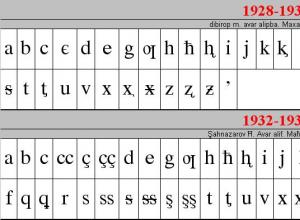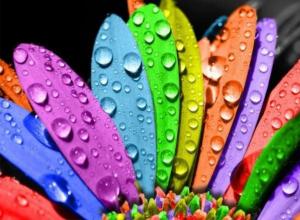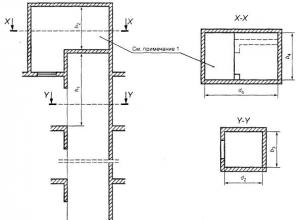How to make eyes from polymer clay. How to make a dragon's eye. Iris and pupils
DIY polymer clay pendant. Master class with step-by-step photos
Master class: "Dragon's eye" made of plastic
As children, many of us were told tales about mystical creatures: whose roar could awaken the dead, whose eyes sparkled in the dark and whose teeth were sharper than any dagger... about Dragons. The mythological dragon symbolizes the test that must be passed in order to obtain treasure. Therefore, a person who wore something associated with a dragon had enormous strength, and especially protection from any illness. The Dragon also symbolizes power, wisdom and greatness. The earliest recorded myth about these creatures dates back to Sumerian culture and tells how the god Ninurta defeated the dragon-like monster Asag, took his eye and became the greatest ruler. We are against violence! Therefore, I propose to make a pendant in the form of a dragon's eye from polymer clay.
Potapova Marina Mikhailovna, teacher of applied arts.
Purpose: for teachers, teachers of additional education, for everyone who craves creativity, recommended activities at school and in creative centers for children from 10 years old.
Purpose: This Master Class is very simple to make, but looks very impressive. Work is more likely to attract boys' attention. After receiving the pendant, my nephew reads stories and legends and is interested in mythology in every possible way. This pendant is perfect as a gift or souvenir.
Target: Introduction to the manufacture of products from polymer clay, the mythical world, which is comprehended through one of such forms of knowledge as creative needlework and modeling.
Tasks:
- to foster a culture of behavior in the classroom, to cultivate neatness when working.
-develop children's imagination and creativity in the manufacturing process
pendant, to arouse educational interest before and after work.
-Introduce children to ancient legends and stories about dragons.
Safety precautions:
Safety precautions:
I took the plasticine in my hands,
Crushed, pressed, twisted, molded.
I smeared all over their hands,
Subdued to his will.
- It’s not for nothing that there is a phrase “I smeared all my hands with them.” Before starting work, be sure to wash your hands well, otherwise the clay will get dirty or simply stick to your hands.
- When working with the blade, be extremely careful, ask adults for help!
- When baking the finished product, carefully read the instructions on the package; clay from different companies has its own special qualities and baking temperature.
Let's get to work!
For work we will need:* Mixed clay (light green and dark green)
*Black clay
*Piece of yellow polymer clay
*Blade
*Crayons (orange and green)
*Round Dotz
*Regular toothbrush
*Tassel
*Super glue
*Black and clear varnishes
*Unnecessary chain.


Step-by-step manufacturing process:
1. We sculpt a droplet from yellow polymer clay, like this:
2. Roll a ball from a mixture of green and yellow clay:

3. Roll black polymer clay like ordinary dough:

4. We place the yellow droplet on the black layer, give the green ball a triangular shape and also place it on the layer:

5. Now roll out a thin “sausage” from a mixture of light and dark green clay:

6. We lay the resulting “sausage” in two rows and cut off the ends:

7. Now we roll the sausage and give it the shape of the upper eyelid:

8. Attach it to the eye:

9. Now we cut out our eye, trim the black clay:

10. Roll small green balls.

11. Now, with the help of dots, we attach the balls to the eyelid and press them down to make pimples:

12. Use a toothbrush to give your eyelids an uneven texture:

13. Now use a blade to cut the orange crayon and paint the tip of the eye:


14. Now let's tear off one ring from the chain and stick it into the product. Afterwards we bake our eye. In my case, 30 minutes (it all depends on the clay you purchased)

15. Using black varnish we draw a comma:

16. Now we put a white dot on top of our comma and cover the eye with transparent varnish:

17. And now the last step, to make the eye look more believable, we fill the entire pupil with transparent super glue - this creates a lens effect.

Our pendant is ready!


This is the realistic eye we got. I did this master class at the request of the boys in our creative group, but believe me, the girls were just as pleased with it.
Today I had a dream -
- I'm in clear sky, I'm a dragon!
I won’t forget the happiness of flying
But it's time to wake up, work and live.
how is it hard for me to come back
It's so easy in the clear sky!
I want to wish everyone creative success and hope that you liked my pendant!
This article presents a master class on sculpting a dragon's eye. This could be a separate pendant with an eye, a brooch, or part of some other decor. In any case, you will need a glass cabochon, some kind of modeling compound, tools for creating texture and paint.
The dragon's eye can be given a wide variety of looks, as you will see if you look at photos of works created by different authors. You yourself can create such a unique work that suits your tastes and your personality. This pendant is a great gift for fantasy lovers, fans of Game of Thrones, Tolkien or any other fairy tales that feature dragons.
To create such a pendant, only basic modeling skills are enough. The eye can be made more realistic or more fantasy and decorative by adding various curls, waves, rings, indentations, and beads.
To create an eyeball, a cabochon is used - a glass stone, the back of which is painted with paints. But you can also simply print out a ready-made drawing of the pupil and iris on a color printer and glue it to the glass stone using PVA glue. Next, the cabochon is fixed on a layer of polymer clay and the area around the eyeball is sculpted, and with the help of tools a skin texture is created on it. The last stage is coloring the skin. You can also varnish the work if necessary.
When the glass eye is dry, you can begin to create eyelids and folds of skin around it from polymer clay. For this you will need: polymer clay for modeling, tools for applying designs to clay, metallic, pearlescent or any other paints that you plan to use for tinting and painting the dragon’s skin. Varnish to cover the work - optional.

It should be said that such a dragon eye can be used not only as a pendant or brooch, but also have other uses. For example, some create such stucco decoration on jars or glasses. Decorating the covers of notebooks and notepads with such stucco is also very popular.

Today is my first master class, but not my first work with polymer clay. I will try to describe it step by step in as much detail as possible, so that it is clear even if you have basic knowledge of polymer modeling.
It often happens that the toys that we create with love and put a part of ourselves into them run the risk of being tattered, and we want to protect them from possible loss of body parts. For example, I understand that most of my toys will fall into children's playful hands, and there is a risk of an eye or nose being torn off, but in the case of a sew-on design, the risk becomes much less! Plus you can add extra glue! So, let's start:
For production we will need:
1. Cardboard backing 10 by 10 cm (for convenience).
2. Wire cutters and round nose pliers.
3. Tools for working with polymer clay (each master has different stacks, which one is more convenient for everyone, everything is individual).
4. White and black polymer clay (depending on the desired size).
5. Galvanized or copper wire about 0.8 cm thick, it can be thicker, but not more than 1.2 mm, because it will be inconvenient to bend.
6. Acrylic paints, brushes, acrylic varnish.
7. Cutters of any type that are available.
8. Rolling pin for rolling out polymer clay.
9.Scissors
Step 1. Take the wire, measure it approximately 5-6 cm and bite it off with wire cutters. For the nose I will make two loops, for the eyes - one at a time, so we cut off 4 pieces of wire.
Step 2. Using pliers, bend the pieces of wire in half first, then press the edges to form a small loop.

Step 3. Insert the sharp end of the wire into the cardboard. It is better to maintain a distance of at least 3-4 cm, otherwise it may be inconvenient to work. It is better to make the holes in advance and widen them with wire, so it will not bend.


Step 4. Holding it from below with two fingers, carefully bend the edges of the wire using pliers. If the loop accidentally pops out during bending, don’t be alarmed; you can always put it back in. After all, the main function of cardboard here is not so much fixation, but rather to create a flat surface for the future product.

Step 5. Still holding the loop with your fingers from below, carefully bend the sharp edges inward, trying to ensure that the bent tails are the same size. We calmly bite off the excess with pliers. These are the hooks we got.

Step 6. Let's start making the nose and eyes. Personally, it’s always more convenient for me to first make a preliminary sketch on paper/cardboard, and then try it on polymer clay or the finished product. Therefore, in this case we draw an eye and a nose, the drawing of the nose on the left is a test one - I applied it to a teddy bear and realized that it was too big. And I tried on the size of the eyelid by eye, since we will have it with the upper eyelid for drama. Then cut along the contour.

Step 7. Let's start making the nose. We take a piece of black polymer clay, knead it until soft, roll it out on a backing board to the desired thickness of the future nose, put the nose pattern on top and carefully cut out the polymer clay along the contour.


Then we remove the nose pattern and smooth out the edges, you can use tools, you can use your finger wrapped in a plastic bag, or even just your finger, but gently.
Step 8. Then we take the nose blank and carefully place it on the hooks and glue it to the paper, you need the hooks to fit tightly into the clay, for prevention - you can remove the hook from the cardboard - carefully align the bottom edge so that the wire wings do not stick out and glue it back on cardboard. It should look like this:



Step 9. We begin to draw out the structure of the nose. In the middle, not reaching the top edge of the stack, draw a vertical furrow. Then, using a round stack, we squeeze out the nostrils; you can go a little under the outer wing of the nose to create depth. And then we draw furrows from the nostrils to the right and left and down to the tip of the nose.

Step 10. Then we create a rough structure, either with a stack or with the eye of a thick needle. And in principle, the blank of our nose is ready, you can either leave it alone, or, if you are afraid of damaging it in the process, carefully remove it from the cardboard and put it aside.

MAKING EYES
Step 11. Let's start making the eyes. Yes, I almost forgot - after the black polymer we definitely go and wash our hands or use wet wipes, otherwise we risk leaving unsightly stains on the beautiful white clay.
The principle of making eyes is basically the same as that of the nose. The only hemorrhoids that you can get in the process is suddenly different eye sizes, so there are two options for solving the problem - either roll out the sausage from polymer clay and divide it into two identical pieces, or do what I do - roll out one pancake and cut it out two eyes at once (with the help of a template it is incredibly easier than trying to draw a perfect circle yourself with a cutter). If one eye is still larger than the other, you can always cut off the excess and carefully align it, so we are not afraid of asymmetry.


Step 12. Next, the scheme is the same - cut along the contour with a cutter, remove the template, carefully use paws or a stack to level the edge and place the blank for the eye on the hooks. Carefully remove the hook from the cardboard and level the lower surface of the eye so that only the loop protrudes.

Step 13. Then we insert the eyes back into the cardboard and carefully align them plus create a bulge.

Step 14. Making the eyelids. So - first we roll out a very thin pancake from polymer clay. Then we carefully cut out two identical strips of polymer clay, the length is not important, they will still be trimmed later.


Step 15. Carefully take a strip of clay and place it on the eye the way we would like the eyelid to go.

Step 16. Carefully trim the excess edges, smooth the remaining edges with a stack.


Step 16. Separate the eyes and nose from the cardboard, carefully place them on foil / in foil / in a baking bag. Don't forget about safety rules as well. Place it all in the oven to bake for 25-30 minutes. So, what we ended up with:


Step 17. After baking, you can start painting. In my example, I use acrylic white, emerald, brown, ocher and black acrylic paints. Then I covered the eye and nose with acrylic varnish (I use car varnish) in several layers, let it dry for a day, then sewed and glued the eyes onto the bear.


And here, in the end, is the very bear for whose sake all this was started! Meet Sir Flexington! (The bear, by the way, is also hand-sewn).


Report to moderator
Dedicated to all toy optometrists and those who do not use factory parts.
A simple design on how to make eyes for a toy, so you can glue and sew on it at the same time.
We will need:
1. Small thick cardboard and paper or parchment of the same size.
2. Polymer clay - here it is black (and if there are different remains, you can also paint them later).
3. Wire (strong enough, but flexible).
4. Round nose pliers, wire cutters.
5. Acrylic white (gloss here) + paints for the iris (if b/w eyes seem boring).
6. Acrylic varnish.
8. Plastic softener (or whatever you use to smooth it out).
Using wire cutters, we cut the wire into 4-5 cm segments; approximately in the middle of the segment, we twist the loops with round pliers.

Consider the distance around it to be at least 2-3 cm, otherwise it will be inconvenient to work.



Knead the clay and glue the “squiggles” to paper or parchment in small pieces.
Why not just cardboard? It can be colorful, which will complicate the dimensions and painting, and the plastic may not stick well... Cardboard can be used several times, changing the stained paper :)
Important! The amount of plastic surgery for each pair may be different, but the amount for the eyes in a pair is equal.

1. Work with a raw workpiece - this is how it works here.
2. After baking the structure, apply the finishing layer.
The plastic was measured, distributed, rolled into balls, weaved and applied to the base... Smoothed to the bottom until a hemisphere was formed.

To make it more smooth, we use a plastic softener... Next, bake!

And if you spend a little more time, even beginners can do colored ones.
Here a crescent and highlights were painted with white paint, and in one of the options there was a colored iris (gradient).

We wait until everything dries and coat it with varnish. Matte or glossy varnish is up to the creator.
Idea! I just visited :) If the paints do not change color when baked (which, unfortunately, happens), you can use transparent liquid plastic :) Of course, you can fill it with epoxy resin, you say :) I haven’t done any experiments with it yet, but I’ll get there :)

We take out the buttons from the cardboard as we take out the tablets. You can also take pliers and flatten the loop - we get such a sewing pin.
In three words about attaching the eyes: a hole is made in the “retracted” eye sockets, and the back side is lubricated with glue. A fair number of threads have already been wound onto the loop pin, and in the end they were stuck, glued and sewn.
Here is my first bear, with the simplest eyes (a crescent moon and two highlights).

Good luck to all! Try new things!
I completely disliked the purchased eyes: the glass ones are not bright and expressive enough, the acrylic ones have a strange bulge above the iris and the sclera is not white enough (which is very noticeable on a doll made of flumo that is not tinted in the mass), and besides, both of them do not have ( as I call it) eyeshadow - darkened irises at the top, highlighted at the bottom. Taking into account all of the above, listening to good advice and reading everyone, I made homemade false eyes, and the result suited me. It’s a pity that the photo doesn’t show the full depth of the gaze and the wonderful glare =)
Apply to the orbits from the inside, sprinkled with talc
Looks very natural
Carefully remove and bake
Make it beautiful with a Dremel, sand it
Insert into place, outline the iris and pupil
Drill out a convex sphere for the iris
Drill out the pupil. A lyrical digression about the pupil. It turned out very beautifully on my test eyes: a deep pupil, enhanced by the effect of the corneal lens. But I couldn’t avoid the bubbles - I couldn’t spill either enamel, epoxy (even if it was cut off on a battery), or varnish into a thin hole with a diameter of less than a millimeter. If I figure out how to solve this issue, I’ll write it down later, but for now I’ll advise you not to drill out the deep pupil, but just outline it a little.
We put it in place and check the look.
Now let's paint. It's a difficult and painstaking task. Since it’s a casserole, of course, acrylic. I don't like it, but it has advantages. It dries quickly, and when it’s dry you can clean it up with a blade if it gets off the edge somewhere. There are drying retardants for acrylic paints in nature; I bought them, but never tried them - somehow I got the hang of it. Another nuance is that it is quite difficult to choose a natural palette. I used a ref photo of green eyes (there is a danger of making the color too bright, unnatural). So, let's get started: paint the iris with an even medium color
Lighten the middle (with a ring), applying radial strokes in a lighter tone
The next layer is even lighter - at the bottom of the iris
Now we take the color several tones darker and emphasize the contours of the iris, and also apply light radial strokes
Painting the pupil
Darken the top of the iris (like an eye shadow)
We imitate the shadow of the eyelid and on the sclera (I used black pigment), and also apply a little pink tone to the corners of the eyes
After this stage, numerous experiments began, during which I came to the following scheme:
First we cover the entire eye with glassy varnish - acrylic glassy varnish - thick, transparent, very glossy, with good fluidity. If it “held a drop”, I would use it for the entire cornea, but alas, it spreads. Therefore, we only cover the sclera with it and fill the recess of the pupil
Here is just a small part of the experiments: jewelry enamel, glassy varnish, epoxy transparent glue.
A lyrical digression about jewelry enamel. Inna () advised me to use Kavalin jewelry enamel. I bought it, but without specifying about the catalyst, I took it for round surfaces. Maybe that’s the whole point - it just didn’t work out for me with the enamel) Firstly, it’s difficult to choose the proportions - 10:4. If you make a slight mistake in one direction or the other, it won’t harden, or it will be brittle and crack. Secondly, it’s a little unclear - at least what do you do with it! If you dry it in the oven (60 degrees) it will be less cloudy, but still. Thirdly, there are bubbles - it’s impossible to mix without them! On the jewelry forum they advise using a hair dryer - yes, it works, the enamel liquefies and the bubbles burst. But in the case of thin application, a bubble from a drop 3 mm thick cannot be removed by anything, in any way! In terms of strength, of course, it is good, and perhaps I will find a use for it. I already wrote about glassy varnish above - it’s good for everyone, but it spreads, doesn’t hold its shape, and of course, is much inferior in strength to enamel. Then I decided to try just transparent epoxy glue, like this one:
It costs 300 rubles, it is available in Peredvizhniki, and I was completely satisfied with it.
We apply identical eye drops and place them on the battery for 1 minute.
Warm mixes better - less stirring movements, fewer bubbles. Stir on a smooth surface, very slowly and carefully. It thickens quickly, so we have literally a few minutes for all our manipulations.
Take a toothpick and apply a drop to the iris, making sure that the drops are symmetrical (and that there are no bubbles!)
All 4 sets.
Latest site materials
Children's creativity

Basic canons. The canon is a prayer. Canon as a hymnographic genre in the Orthodox tradition
Orthodox literary works contain an inexhaustible source that allows one to communicate with God. The canon is considered one of the types of church verbal art. The difference between the canon and the akathist Prayer is an invisible thread between people and God, it is spiritual unrest
Holidays

Abstract artificial languages What are artificial languages?
Esperanto is the most widely spoken artificial language in the world. Now, according to various sources, from several hundred thousand to a million people speak it. It was invented by the Czech oculist Lazar (Ludwig) Markovich Zamenhof in 1887 and received its name
Health

Avar language: its structural features and history Who speaks the Avar language
Language Avars (self-name - Avaral, Ma'arulal) are the largest people of modern Dagestan. They inhabit most of the mountainous part of Dagestan, and partly the plains (Buinaksky, Khasavyurt and other regions). In addition to Dagestan, they live in Chechnya, Kalmykia, etc.
Why

Characteristics of the name fiza Name as a phrase
The name Fiza is not just a set of letters or a column on a birth certificate, but, without exaggeration, an energetic message to the future. Knowing what the name Fiza means, the meaning of the name Fiza, the origin of the name Fiza, what nationality the name Fiza has, m
Development up to a year

Legislative framework of the Russian Federation Depth of the elevator hall in a public building
GOST 5746-2003 (ISO 4190-1-99) INTERSTATE STANDARD PASSENGER ELEVATORS Main parameters and dimensions INTERSTATE COUNCIL FOR STANDARDIZATION, METROLOGY AND CERTIFICATION Preface1 DEVELOPED by the Technical Committee for Standardization TC 209 “Elevators
Child nutrition

Suffixes in Japanese names How to spell chan in Japanese
In the Japanese language, there is a whole set of so-called nominal suffixes, that is, suffixes added in colloquial speech to first names, surnames, nicknames and other words denoting an interlocutor or a third party. They are used to denote social
